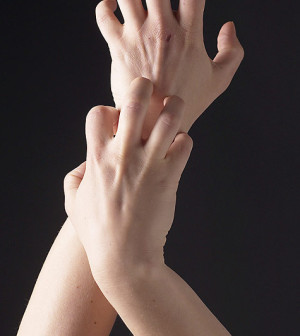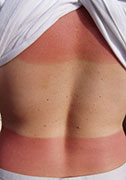- Skip Storing This Everyday Product in the Fridge Door
- Green Tea + B3 Pairing May Boost Brain Health
- Navigating Your Midlife Crisis: Embracing New Possibilities
- City Raccoons Showing Signs of Domestication
- Mapping the Exposome: Science Broadens Focus to Environmental Disease Triggers
- One Week Less on Social Media Linked to Better Mental Health
- Your Brain Changes in Stages as You Age, Study Finds
- Some Suicide Victims Show No Typical Warning Signs, Study Finds
- ByHeart Formula Faces Lawsuits After Babies Sickened With Botulism
- Switch to Vegan Diet Could Cut Your Greenhouse Gas Emissions in Half
Sun’s Damage Lingers Long After Dark


Skin damage caused by ultraviolet (UV) radiation continues long after you get out of the sun, even in the dark, a new study says.
Researchers explain that UV light from the sun or tanning beds can damage DNA in melanocytes. Melanocytes are cells in the skin that make the substance called melanin. Melanin gives skin its color. Damage to melanocytes is a major cause of skin cancer, according to the researchers.
It was thought that melanin protected the skin by blocking UV light, but this study found that melanin has both protective and harmful effects.
Researchers exposed mouse and human melanocytes to UV radiation. In melanocytes with melanin, DNA damage occurred not only immediately, but also hours after UV exposure ended. In melanocytes that didn’t have melanin, the damage occurred only during UV exposure.
“If you look inside adult skin, melanin does protect against [DNA damage]. It does act as a shield. But it is doing both good and bad things,” said study author Douglas Brash in a Yale University School of Medicine news release. He is a clinical professor of therapeutic radiology and dermatology at Yale.
Scientists explained the process that caused DNA-related damage in the dark. UV light activated enzymes that stimulated melanin. This process, called chemiexcitation, created the same DNA damage in the dark that sunlight caused in daytime, according to the researchers.
Chemiexcitation is a slow process and it may be possible to develop ways to prevent it, such as “an evening-after” sunscreen that might be able to block the transfer of damaging energy to the skin cells, the researchers said.
The study was published online Feb. 19 in the journal Science.
More information
The U.S. National Cancer Institute has more about skin cancer prevention.
Source: HealthDay
Copyright © 2025 HealthDay. All rights reserved.










